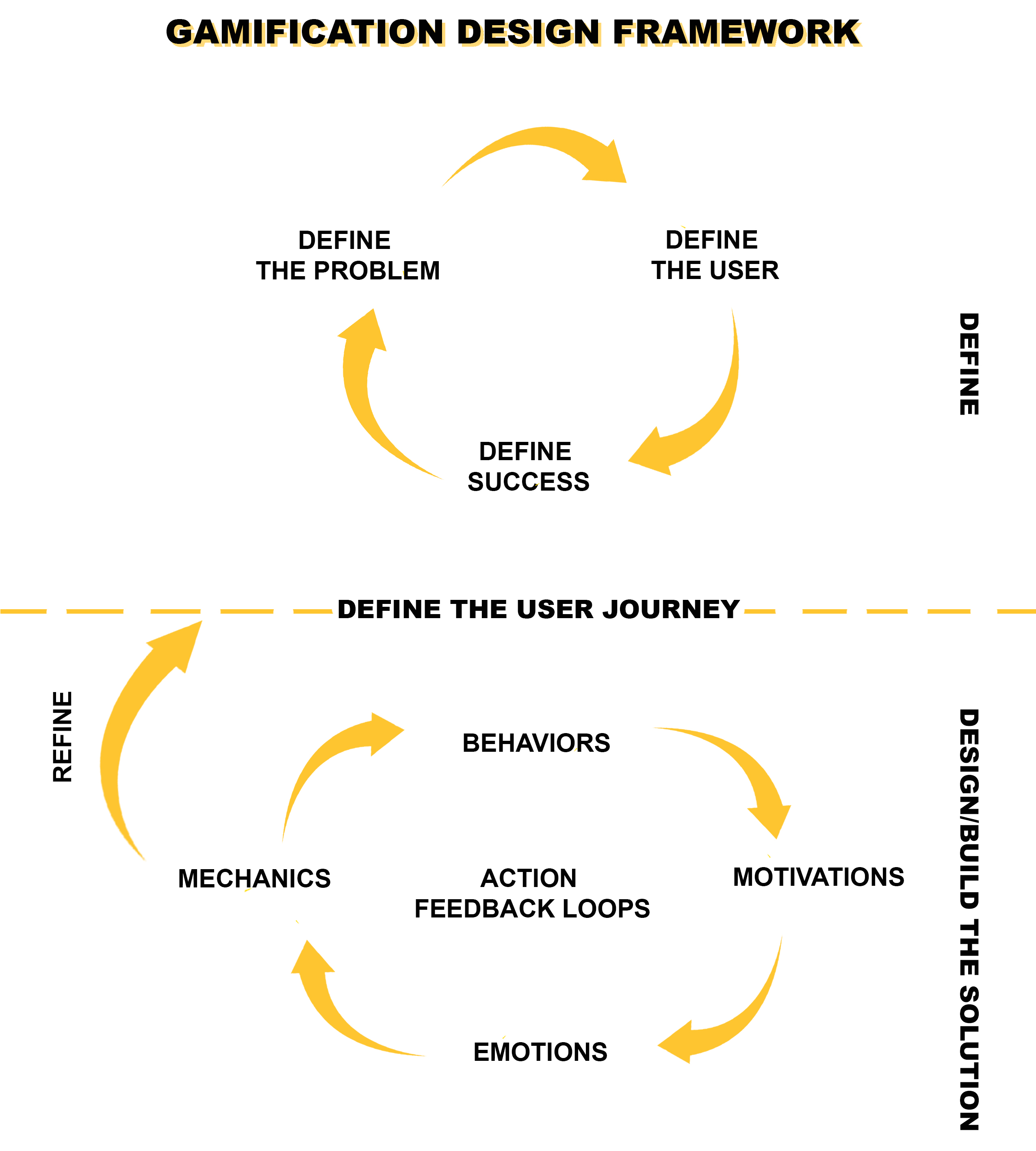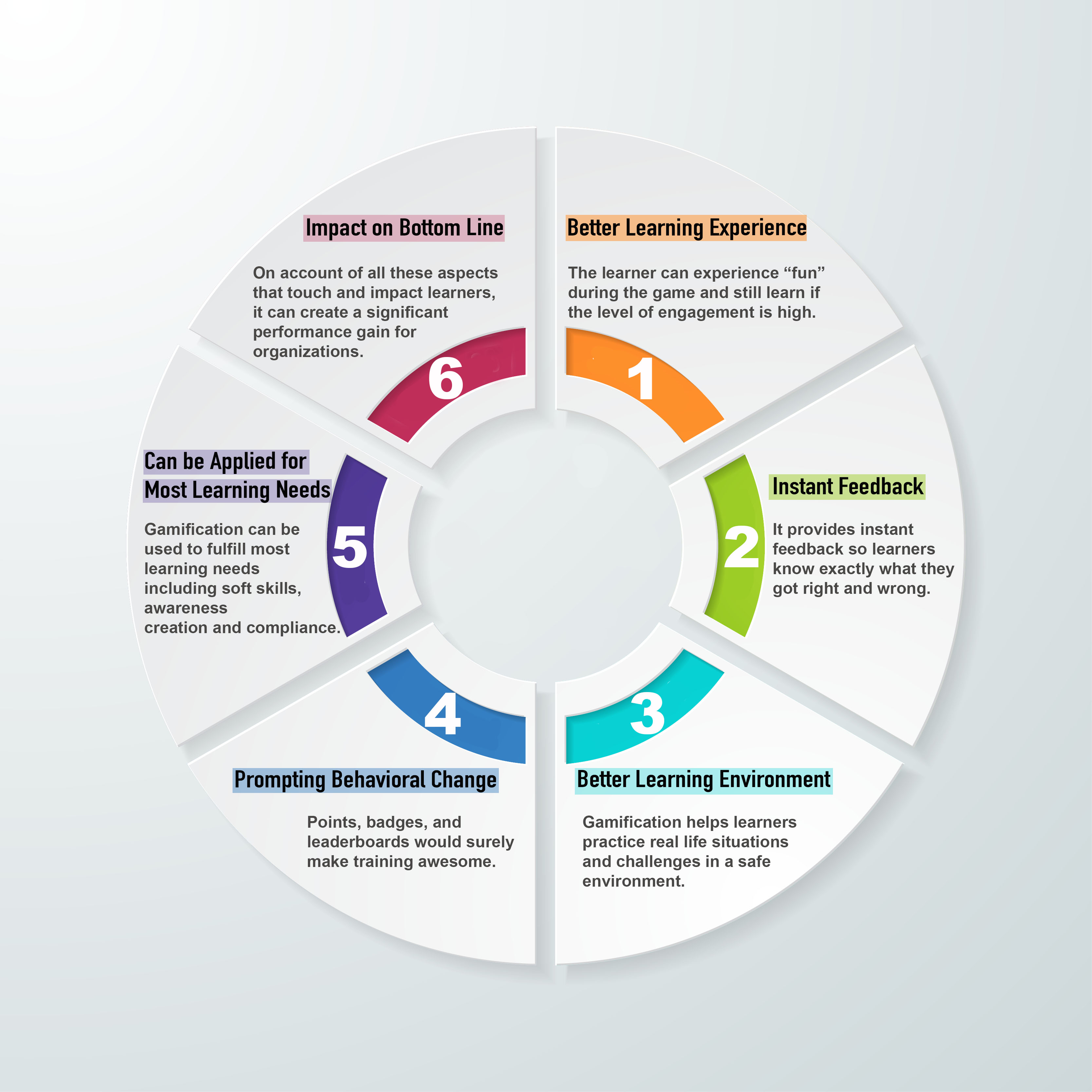Gamification
Table of Contents
- Overview
- Gamification Framework
- How to Apply Gamification to Your Content
- Recommendations
- References
Gamification VS Game-Based Learning
Watch Karl Kapp explain the difference between Gamification and Game-Based Learning.

To apply gamification strategies, you can go as simple or as complex as you want. Some effective techniques are highlighted below: (some of the best elements to gaming are earning points and leveling up, collecting badges and trophies, participating on a leaderboard, multiple tries to get it right (lives), and choices).
Experience Points
In traditional classroom structures, students earn grades by losing points. In video games, players gain experience points (XP) to level their characters up. Implement a grade schema that mimics using XP. The Growth Engineering blog talks about using XP in a training context, but the lesson can be applied academically.
Badges & Trophies
Remember when you used to get stickers on your homework? Those were the days. Badges and trophies work the same way and are used to recognize accomplishments in a course. For example, if you have a writing course and want students to attend a workshop hosted by the Writing Center, you could then reward them with a “Writing Hero” badge or trophy for their effort. Students may find it fun to try to collect as many badges/trophies as they go along.
In his blog post, Bernard Bull, gives some suggestions for how to use digital badging in your course.
- Establish a badge system design that scaffolds the learning experience, requiring certain competencies before proceeding to more complex course challenges.
- Use badges to require ongoing evidence of certain knowledge and skills over an extended time.
- Help students recognize their progress from basic skills to mastery using badge levels.
Read more at 10 Promising Practices & Possibilities for Using Digital Badges in Your Courses.
Leveling Up & Stages
This suggestion is more about setting the mood of the course. Any gamer knows that character progression in a game is called leveling up. And progression of the game moves through stages. So, if you want to incorporate gaining XP in your grading schema, you can combine it with a simple naming convention of calling your modules “stages” and giving the students new titles when they reach specific amounts of XP gained. For instance:
0 – 100 XP = Newbie
101 – 200 XP = Novice
201 – 300 XP = Dragon Slayer
Basically, anything you want that makes sense in your course!
Role-Play
It doesn’t have to always be about emulating fighting games! The Faculty of Education at the University of British Columbia gamified one of its online courses on adult education. Elements of the game included role-playing, giving the "gamer" the ability to choose which tasks to complete, public acknowledgement of achievements, as well as a peer-voting system.
Watch the learning design manager, the instructor, and a student of this course talk about how the various gaming aspects of the course motivated, empowered, and engaged the students.
Customization
Allowing students to customize their content is not only great for motivation; it is best practice for creating accessible content via the Universal Design for Learning (UDL) framework. It gives students choices for how to complete assignments (paper, presentation, video) or participate in discussions (text, audio, video) whenever possible. And it allows students the chance to fail and retry low-stakes quizzes (games having multiple lives).
Pros & Cons for Gamification
Depending on how and where you use gamification in your course, the benefits will vary.
- Can increase student engagement
- Can help provide the motivation to complete the course
- Students are likely to spend more time on learning as the courses are fun and enjoyable
- Frequent feedback opportunities allow for deeper understanding of materials
- Students can connect socially in a familiar way
- Gamified courses lead to high performance learning and help learner in committing knowledge to long-term memory
There are cons involved in gamifying your content.
- Could possibly decrease student attention span
- Lots of initial time is needed to plan the course or build the content
- When choosing which elements to gamify, you must make sure to keep it relevant and useful
Benefits of Gamification in Online Learning

External Links
Gamification in D2L Webinar offered by ETSU (long, but worth it! Bring popcorn!)
Really neat example of Gamification through the creation of an escape room.
E-Learning Gamification Made Simple [video] by E-Learning Uncovered.
Flippity Tutorial for Course Gamification [video] by Ever Educating
Create Digital Badges for Students [video] by Ever Educating
E-Books
These books are available at KSU Library:
Bell, K. (2018). Game on!:Gamification, gameful design, and the rise of the gamer educator. Johns Hopkins University Press.
Information Resources Management Association. (2018). Gamification in education: Breakthroughs in research and practice. Information Science Reference.
Research
Boskic, N., & Hu, S. (2015, October 8-9). Gamification in higher education: How we
changed roles [paper presentation]. The 9th European Conference on Games Based Learning,
Norway. https://ets.educ.ubc.ca/ecgbl_gamification-in-higher-education_boskic_hu/
Ortiz, M., Chiluiza, K., & Valcke, M. (2019). Gamification through leaderboards: An empirical study in engineering education. Computer Applications in Engineering Education, 27(1). 10.1002/cae.12116
-
References
Denton, M. (n.d.) 11 benefits from gamified learning [blog post]. Retrieved from https://www.gamify.com/gamification-blog/11-benefits-from-gamified-learning.
Hitchens, M., & Tulloch, R. (2018). A gamification design for the classroom. Interactive Technology and Smart Education, 15(1), 28-45. doi: http://dx.doi.org/10.1108/ITSE-05-2017-0028











